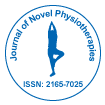మా గ్రూప్ ప్రతి సంవత్సరం USA, యూరప్ & ఆసియా అంతటా 3000+ గ్లోబల్ కాన్ఫరెన్స్ ఈవెంట్లను నిర్వహిస్తుంది మరియు 1000 కంటే ఎక్కువ సైంటిఫిక్ సొసైటీల మద్దతుతో 700+ ఓపెన్ యాక్సెస్ జర్నల్లను ప్రచురిస్తుంది , ఇందులో 50000 మంది ప్రముఖ వ్యక్తులు, ప్రఖ్యాత శాస్త్రవేత్తలు ఎడిటోరియల్ బోర్డ్ సభ్యులుగా ఉన్నారు.
ఎక్కువ మంది పాఠకులు మరియు అనులేఖనాలను పొందే ఓపెన్ యాక్సెస్ జర్నల్స్
700 జర్నల్స్ మరియు 15,000,000 రీడర్లు ప్రతి జర్నల్ 25,000+ రీడర్లను పొందుతున్నారు
ఇండెక్స్ చేయబడింది
- ఇండెక్స్ కోపర్నికస్
- గూగుల్ స్కాలర్
- J గేట్ తెరవండి
- జెనామిక్స్ జర్నల్సీక్
- అకడమిక్ కీలు
- సేఫ్టీలిట్
- RefSeek
- హమ్దార్డ్ విశ్వవిద్యాలయం
- EBSCO AZ
- OCLC- వరల్డ్ క్యాట్
- పబ్లోన్స్
- ICMJE
ఉపయోగకరమైన లింకులు
యాక్సెస్ జర్నల్స్ తెరవండి
ఈ పేజీని భాగస్వామ్యం చేయండి
నైరూప్య
Effects of Therapeutic Exercises on the Quality of Life and Upper Limb Muscle Strength of Individuals with Bi-Ventricular Heart Failure
Ajiboye OA, Anigbogu CN, Ajuluchukwu JN, Jaja SI
Background: Despite remarkable progress in heart failure management, fatigue, Breathlessness, exercise intolerance and muscle wasting remain the hallmarks of the disease leading to impaired quality of life (QoL) and capacity for activities of daily living (ADLs). This study aimed to examine the effects of exercise training on the healthrelated quality of life and upper limb strength of individuals with bi-ventricular heart failure (BVF).
Methods: Sixty-six subjects with chronic BVF in Class II and III of the New York Heart Association were recruited from a Nigerian tertiary Hospital and randomized into two groups, the Exercise and the Control groups. Both groups were on their prescribed medications and underwent education/counselling sessions. The exercise group performed aerobic and resistance training three times a week for 12 weeks while the control group did not engage in any exercise training. The quality of life of the subjects was assessed using the Kansas City Cardiomyopathy Questionnaire (KCCQ) and SF-36 questionnaire. The hand dynamometer and One Repetition Maximum (1RM) were used to determine the handgrip and upper limb strengths. Data were analysed using the SPSS Package version 22 and presented using descriptive statistics of Mean ± SEM. The level of significance was set at p < 0.05.
Results: The results showed that the exercise group experienced significant improvement in all domains of QoL, upper limb strength and grip strength while the control group only showed significant improvement in the Knowledge and Perception domains.
Conclusion: It can be concluded that therapeutic exercise positively impacts the general health and symptoms experienced by individuals with Chronic Bi-ventricular heart failure. This suggests that exercise training should be considered a beneficial intervention for improving QoL and muscle strength of individuals with bi-ventricular heart failure.
సబ్జెక్ట్ వారీగా జర్నల్స్
- ఆహారం & పోషకాహారం
- ఇంజనీరింగ్
- ఇన్ఫర్మేటిక్స్
- ఇమ్యునాలజీ & మైక్రోబయాలజీ
- ఎకనామిక్స్ & అకౌంటింగ్
- కంప్యూటర్ సైన్స్
- కెమికల్ ఇంజనీరింగ్
- క్లినికల్ సైన్సెస్
- గణితం
- జనరల్ సైన్స్
- జియాలజీ & ఎర్త్ సైన్స్
- జెనెటిక్స్ & మాలిక్యులర్ బయాలజీ
- నర్సింగ్ & హెల్త్ కేర్
- పర్యావరణ శాస్త్రాలు
- ఫార్మాస్యూటికల్ సైన్సెస్
- బయోకెమిస్ట్రీ
- బయోమెడికల్ సైన్సెస్
- భౌతిక శాస్త్రం
- మెటీరియల్స్ సైన్స్
- మెడికల్ సైన్సెస్
- రసాయన శాస్త్రం
- వెటర్నరీ సైన్సెస్
- వ్యాపార నిర్వహణ
- సామాజిక & రాజకీయ శాస్త్రాలు
క్లినికల్ & మెడికల్ జర్నల్స్
- అంటు వ్యాధులు
- అణు జీవశాస్త్రం
- అనస్థీషియాలజీ
- ఆరోగ్య సంరక్షణ
- ఆర్థోపెడిక్స్
- కార్డియాలజీ
- క్లినికల్ రీసెర్చ్
- గ్యాస్ట్రోఎంటరాలజీ
- జన్యుశాస్త్రం
- టాక్సికాలజీ
- డెంటిస్ట్రీ
- డెర్మటాలజీ
- నర్సింగ్
- నెఫ్రాలజీ
- నేత్ర వైద్యం
- నేత్ర వైద్యం
- న్యూరాలజీ
- పల్మోనాలజీ
- పీడియాట్రిక్స్
- పునరుత్పత్తి ఔషధం
- ఫిజికల్ థెరపీ & పునరావాసం
- మందు
- మధుమేహం & ఎండోక్రినాలజీ
- మనోరోగచికిత్స
- మైక్రోబయాలజీ
- రేడియాలజీ
- రోగనిరోధక శాస్త్రం
- సర్జరీ
- హెమటాలజీ

 English
English  Spanish
Spanish  Chinese
Chinese  Russian
Russian  German
German  French
French  Japanese
Japanese  Portuguese
Portuguese  Hindi
Hindi